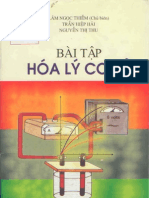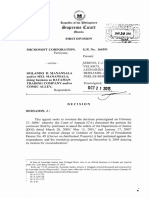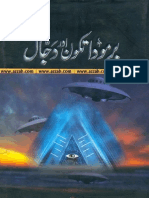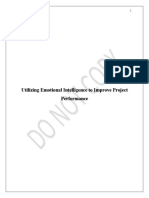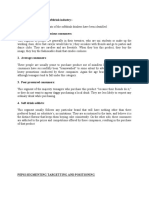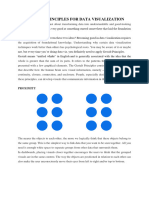Ultra-Violet Rays As Aid To Restoreres
Ultra-Violet Rays As Aid To Restoreres
Uploaded by
Aafke WellerCopyright:
Available Formats
Ultra-Violet Rays As Aid To Restoreres
Ultra-Violet Rays As Aid To Restoreres
Uploaded by
Aafke WellerOriginal Title
Copyright
Available Formats
Share this document
Did you find this document useful?
Is this content inappropriate?
Copyright:
Available Formats
Ultra-Violet Rays As Aid To Restoreres
Ultra-Violet Rays As Aid To Restoreres
Uploaded by
Aafke WellerCopyright:
Available Formats
TECHNICAL STUDIES
IN THE FIELD OF THE FINE AI\. TS
Published for the Fogg Art Museum, Harvard University
EDITORIAL BOARD
Chairman of tlze- Advisory Committee: EDWARD W. FoRBES
Managing Editor: GEORGE L. STOUT Business Managen W. BuFFUM
;Editot"s: ALAN BuRROUGHS and RuTHERFORD J. GETTE.NS
Advisory Committee
\V. G. CoNSTABLE, Courtauld Institute, University of Londort
C. T. CuRRELL.Y, Royal Ontario Museum
AI.EXANDER EIBNER, Research Institut.e for the Technique of Painting, Technical
High School, Munich
PAUL GANZ, University of Basel
A. P. LAURIE, Royal Academy of Arts, London
DENMAN W. Ross, Museum of Fine Arts, Boston, and Harvard University
ALEXANDER ScoTT, Research Laboratory, British London
DANIEL V. THOMPSON, JR., Research Fellow of the American Council of Learned
Societies '
HENRI VERNE, National Museums of France and School of the Louvre -..:
of the Advisory Committee gi':'e aid but are not responsible for the conduct
of fECHNICAL STUDIES. Office of Pubhcatlon, Prmce and Lemon Sts., Lancaster, Pa. The
Editors should be addressed at the Fogg Art Museum, Harvard University, Cambridge, Mass.;
the Business Manager at Prince and Lemon Sts., Lancaster, Pa., or 6 54 Madison Ave., New York
Volume II January, 1934 Number 3
1
CONTENTS
Something about Pastel Technic and its Perman.ence
WALTER BECK I 19
Notes on rthe l\1edium of Flemish Painters ...... A. P. LAURIE 124
Notes on the Experi1nental Studies Made for the Prevention of
Mold Growth on Mural Paintings ........ ARAM H. HATCH 129
Early Restorations of Mediaeval Enamels
MARVIN CHAUNCEY Ross 139
A Chemical Investigation of an Alleged Ancient Greek Bronze
Statuette. ... o .... 0 ,. o. 0 EARLE R. CALEY 144
Notes
Dammat as a Picture Varnish ..... , ...... " .... MAXIMILIAN TocH 149
Ultra-Violet Rays as Aids to Restorers ........ R. ARcAmus LvoN t 53
Trisodium Phosphate Solutions Attack Marble ... ARTHUR H. KoPP 158
Book Reviews ............. ... .. 0 0 159
Abstracts, .................... . . . .... .. . . ..... : . . . . . . . . . . 160
Application for entry as second-class matter at Lancaster, Pa., post office, pending.
Copyright, 1934, Fogg Art Museum .. Made in United States of America.
Issued quarterly $4.00 a year $1.25 a copy :
Canada, $4.'15 a year Foreign, $4.50 year
_- ; '
;, .;f_ i , ..
. - .. , ........
i
i
..; .... 1
'
:; ,I
l
''
I
:1
.,
. ;.
:'1.
.::: I i
i I.
l ,! ., '
. .. . . r .
:i'; .:
i'l:
; ;.
: J i.
r
: .. ; ;!
, :, I
.t
-. I ,
f.
,: :II::
. ,;1
; ;. '
: I. .': 'I
; 1:.
I
?:,r;
. , :
J::>
'I
.l '
;['I
:j ::
r.:.
.f
:1
J;
t
.r.
., i
tk
f
l f
f. t.
I
(
t
,,.
I;
..
. i
i r.
i s:
! r
t \
f r.
l
t
i.
';
!.
i
!
t
t
I
I
t
I
t'
t.
t
l
.[
f
f
'
ULTRA-VIOLET RAYS AS AIDS TO RESTORERS
It is not 1ny intention to delve into the technical side of the ultra-
violet rays, but rather to show the practical use of them to the restorer;
under certain conditions they are efficacious as indicators of the _
amount of previous restoration one n1ay encounter on the painting
under examination. The use of the ultra-violet _rays is many times re-
stricted, however, by a too heavy layer of varnish. The fluorescence of
the varnish in these cases is so active that one can not see the true
condition of the paint film. It is to be admitted that the trained eye
can in most cases detect former restorations, but the eye does not keep
a permanent record of what it sees. The photographic plate does make
a record of the greatest value for the trained or for the inexperienced
workers in this field. If surface conditions permit of obtaining such a
record, it moreover, help to show an owneror the actual
state of the painting at. that time. Ultra-violet rays, Roe_ntgen rays,
and chemical analyses are aids which no can afford to thrust
lightly aside. The Roentgen rays are useful in\ the determination of
authorship and as"indicators of the extent of damages under the re-
painted areas, but they/ do not always give acclirate indications of the
extent of the Many times the glazes, which hide the original
paint, have not enough.opacity to record on the sensitive film used in
making the radiographs. It is thus to be seen that these scientific aids
are not infallible, can only be successfully used .in conjunction with
the trained eye.
Color filters, such as are used in the four-color reproduction proc-
ess, are of great value in obtaining a better record of the Jluorescence
paintings by ultra-violet light. The following description
and illustrations will show the value of the color filter for photography
under the ultra-violet rays, as well as for exposures made with in-
candescent light. Panchromatk plates were used with one exception.
A Corex (\., red-purple filter was used on the lamp.
i
I
l
!.c: WMM- .C4Xw &-l':"&
,_i
I :
I
I
!
i :
i
I
i
1'
I
l
i
I
I
i
i
I
I
I
l
I
I
I
52.
'"' ' .. c: . , -..,...,., t(
J. :Y : . -; -: :.:.:s ;.: :Jit
'\'- .'- . ... , ' .... \ . ....
1'!; .:. , '(
";: . A..\f/-- \ ...... ,. \. . ., :\'
,_. _, . ., .. ,, ,._ .\ : . '- . - .
\t ;.: , ,
... I ... ' . \_ "'' . h)lf
" l \
kl -.'. .. , ... .. ... ''i
__ ,._ ._-. - .. . . ,_. , { f. . . j 'I\
;f' .,. A i : . i t'
"'!>:::'-- j . (!
. . ' ,. ; >jj \I
' '' : ., . ., '\ r l l ' ' f4j )'
:; , ....... _ . .....L."" [.. . ''
' . ', '"\ ' .lll.
(' ft .. ( _:. 1 '
, '.\ ,!>: ........... l . }.. . < ' .:- ii ;
; ' 'I"':'L .. , r . .. 'Jj'jtl
>__. .. '"-.. -: . .. . ... --. --
1 ..
. . . : -. . . . 'J
.
, .. \ . . , ,.: - .. ... : .. . - .. ;I
. . . , .. . ' J) 1
Ji } j ... .. , :. '. . . l ' . t t
;: . . ' : .1 j
.. :; -, . : ., '
1
ti
,. 'l . . l.ti}
r, ,, \ ' ,
\ /. ' ! \It/
' :.: . t \:]f.\!,
:-- J ._ :-,[
f : ..
.. ;..'
;-I) .
;:r( >.
!' -;:..' r,
l - . , l-)
.i
,_ ' f_: __
.. .
'" ' ;-..
I ; : .j!
/'
. / ' / t"J
-4' - ... , " .. ,_ f
, . < ; . .,. ... } .1
... .
-- ,,,< __ .,>"<
... .. . --... -/
.
. "l
. ..
FIGURE I. A portrait of a pope attributed to Girolamo Genga (Fogg Art Museum, No.
19J2.62). .
' '-
(
154 'liECJ?NICAI .. STUDIES
The painting which is shown in the illustrations is attri but eel to
Girolamo Genga (1476-ISSI), U1nbrian School, and is part of the
Fogg Museum collection (No. I9J'2.62). The halftone reproduction
\. '* . ?< .T ,, . .... , , 'f*'"'
.. ..
"
.
.t' 4
'
... -..;.
;,
-J
: _,_. _j
. ; ' 4
;.'l.
:,
:. _;_.(
. . ;:
. .
' .
,,
.'
;'f:
<; _ .. -;;:
..:: ..... '.- .
,:' f . >
. ::
-,_::'-"
: .. , ... (!
.
... ..
"1
.... ew ih""- -4'6 -e _ ...... sri'
FIGURE '2. Fluorescence in a detail of the Genga portrait, photographed on a par speed
plate.
(Figure 1) is from a photograph ofthe painting under incandescent
light before any cleaning had been undertaken_. The retouchings are
so skillfully done that they are hardly visible to the eye, and the
'-
NoTES
ISS
_values are so closely 1natched that even the sensitive plate of the
camera does not record them-a deceptive type of restoration which
is preferred by many collectors.
I . .
I
I - .:1
!
t
[ .
r
I'
[
t
l . ....
I' - -;' . -
f_ - ; .
f _.- .
t- -.
k
t _._ .
r .
. . .
. '\.'"' ..
--
f;, -"': .:\ .: . . .
[."_- -<> .
.... .. .
. : i" .
l
,: .i. :
.. :,
'\._:
f'
, ...
_ ('".1
....
. - .... ' .:' )
. . -
< -. -
' 1
-'<j
:'/i
. ' ...... -......:.. ...... .--;:-. ....... -..---
FIGURE 3 The same area as that shown in Figure 2, and also under ultra-violet light,
but photographed with a red :filter on the camera, and with a panchromatic :film.
When the painting was placed under the ultra-violet rays, the res-
torations were plainly seen as they had taken on a deep, neutralized;
blue-violet tone. The original paint film retained its local color to a
I 56 'fECHNICAL STUDIES
great degree, except for a slight fluorescence due to the thin filn1 of
surface varnish 'which been extended over the whole painting.
The dark tone of the fluorescence seemed to indicate that no color
r -, ,. ... .. ...
.. ;
}};''.: . ... , .... j'_:i:% ;"(.:. Ff.: , ;
f> / ., ., ' I ' ' ' . : / ) l
1
( '.' : .J ' ; . f j
f
ti -; ' ' : .. . :.ij .
' 0 f . , 1 t
.. .. . ;J -:/ . ;. . . -. l "''l.
" . . . J ' . ; 4. )
L - __ .. . . :
.. i
FIGURE 4 The lower half of the Genga portrait photographed like the detail in Figure 3
filter would be needed and accordingly an exposure was made on a
panchromatic film with practically no result as far as recording the
definite demarcation of the restqrations. A par speed plate next
used in order to check the effect of the fluorescence upon this type qf
plate which is practically color-blind.
.)' ..
NoTES
157
Figure 2 will show the result obtained; the arrow points to light
areas which have reversed their tonal value. Under the ultra-violet
rays they appeared a dark blue-violet, although not so mqch neutral-
ized as n1ost of the other restorations. This reversal clearly indicated
that by using the red color filter the blue tones would be recorded dark
on the panchron1atic film. Figure 3 shows same area photographed
under the ultra-violet rays with the red filter . before the lens. The
dark tones of the fluorescence are now recorded in their proper tonal
value as seen by the eye the painting is exposed to the ultra-
violet ra_ys. The reversal of the light spots indicated by the arrow in
Figure 2 is to be noticed. Figure 4 shows the lower half of the painting
and is a vivid exampleof fluorescence excited by the ultra-violet rays.
Perha,ps a word here as to exposures inay help some worker in
making this type of record. First, he must be sure to sharply focus the
image with. the diaphragm wide open, and to stop it down to not
, . 1 I
more thanf I r, for the more open the diaphragm, the more contrast
to the exposure. A well stopped-down wili give detail in the
. lights as as the shadows but the. resultingnegative will lack the
contrast which is obtained by the first type o(exposure. Timing will
have to by the amount of light whlch the diaphragm lets
through, no matter what type of light is used. A- contrasty developer
will also be found: to be of great aid in this
1
work because it will
increase the contrast in the film and if rightly used will not plug the
highlights t.oo muth. A little experience is all tJ\
1
at is needed to obtain
the desired results. R .. i\RCADIUS LYoN
FOGG ART MUSEUM, HARVARD UNIVERSITY
i.
i
You might also like
- Naughty and Nice The Good Girl Art of Bruce TimmDocument251 pagesNaughty and Nice The Good Girl Art of Bruce TimmMmeng Andree BlaiseNo ratings yet
- Fiji PICU GuidelinesDocument189 pagesFiji PICU GuidelinesCaroline RatuNo ratings yet
- Anything Goes: An Advanced Reader of Modern Chinese - Revised EditionFrom EverandAnything Goes: An Advanced Reader of Modern Chinese - Revised EditionRating: 5 out of 5 stars5/5 (1)
- Mumbai CAT Judgement On Pay Scale of Inspectors and SuperintendentsDocument26 pagesMumbai CAT Judgement On Pay Scale of Inspectors and Superintendentshydexcust100% (4)
- Russian ChernozemDocument439 pagesRussian ChernozemScary Creatures50% (2)
- Further Mathematics For Economic Analysi PDFDocument310 pagesFurther Mathematics For Economic Analysi PDFTina CRNo ratings yet
- Roger Garaudy - Why I Became A MuslimDocument105 pagesRoger Garaudy - Why I Became A MuslimOsama MariaNo ratings yet
- The Big Six: 1918-1928Document12 pagesThe Big Six: 1918-1928TheJDDMCL100% (1)
- P51D - Mustang - Maintenance ManualDocument519 pagesP51D - Mustang - Maintenance Manualavialogs100% (12)
- Kowa 6 MMIIManualDocument46 pagesKowa 6 MMIIManualJoseph DaphadileNo ratings yet
- Routing Slip Ufo Iran PDFDocument6 pagesRouting Slip Ufo Iran PDFClifford StoneNo ratings yet
- F T, R Ie %b:.:e: e I - R: Go . '':r:::t. :L !:e R: NDocument2 pagesF T, R Ie %b:.:e: e I - R: Go . '':r:::t. :L !:e R: NCitizens Committee to Save Elysian ParkNo ratings yet
- Communicate What You MeanDocument320 pagesCommunicate What You MeangamblerNo ratings yet
- Housing Court Order For 3569 DeKalb AvenueDocument5 pagesHousing Court Order For 3569 DeKalb AvenueCity Limits (New York)No ratings yet
- 211113049_economicsDocument12 pages211113049_economicsImil EkeNo ratings yet
- Scan Doc0001Document5 pagesScan Doc0001The Republican/MassLive.comNo ratings yet
- Asrar Khudi Rumoz e BekhudiDocument23 pagesAsrar Khudi Rumoz e Bekhudirazzaq507No ratings yet
- Daryn Stafford - Victim Impact StatementDocument2 pagesDaryn Stafford - Victim Impact StatementOmar Ha-RedeyeNo ratings yet
- Having Fun! 1 - Primary Education WorkbookDocument73 pagesHaving Fun! 1 - Primary Education WorkbookPopescu Luiza100% (2)
- Practical Unigraphics NX2 Modeling For Engineers by Stephen M. Samuel - Mark Kelley - Paul Rymarz - Anuranjini PragadaDocument65 pagesPractical Unigraphics NX2 Modeling For Engineers by Stephen M. Samuel - Mark Kelley - Paul Rymarz - Anuranjini PragadaVijay AnanthNo ratings yet
- Citizens Committee To Save Elysian Park - Newsletter Number 026 - March 1969Document2 pagesCitizens Committee To Save Elysian Park - Newsletter Number 026 - March 1969Citizens Committee to Save Elysian ParkNo ratings yet
- The Night The Sky Turned On by John A. KeelDocument8 pagesThe Night The Sky Turned On by John A. KeelJerry Hamm100% (3)
- Activite 4 GestionDocument5 pagesActivite 4 GestionMohamed TaouilNo ratings yet
- Ore DepositsDocument270 pagesOre Depositsdyet100% (1)
- Apasthambha Shrardha PrayogamDocument36 pagesApasthambha Shrardha Prayogamnaradhar100% (1)
- القطاع الثالث والفرص السانحة رؤية مستقبلية 2Document322 pagesالقطاع الثالث والفرص السانحة رؤية مستقبلية 2alwi salamNo ratings yet
- Mhi 102Document19 pagesMhi 102Isha SharmaNo ratings yet
- Citizens Committee To Save Elysian Park - Newsletter Number 094 - February 15, 1985Document2 pagesCitizens Committee To Save Elysian Park - Newsletter Number 094 - February 15, 1985Citizens Committee to Save Elysian ParkNo ratings yet
- L/epublit of TBT .T1bilippines Court Fflanila: UpremeDocument18 pagesL/epublit of TBT .T1bilippines Court Fflanila: UpremeNCMF embernardoNo ratings yet
- Fo:a::-A' - : A., :i . B, d-3. G? Fu - Q : T 1:.,651 ResDocument2 pagesFo:a::-A' - : A., :i . B, d-3. G? Fu - Q : T 1:.,651 ResCitizens Committee to Save Elysian ParkNo ratings yet
- Adobe Scan 20 de Jan. de 2022Document25 pagesAdobe Scan 20 de Jan. de 2022arletejulia71No ratings yet
- Bio ProjectDocument12 pagesBio ProjectakanshakhendkarNo ratings yet
- Directional DrillingDocument7 pagesDirectional DrillingVIRU SINGHNo ratings yet
- 116 - Baitap Hoaly CosoDocument434 pages116 - Baitap Hoaly Cosobi_hpu2100% (2)
- Vumbf S R: R 'Ocrfi Attenc in 'He Oc Ol RstenDocument8 pagesVumbf S R: R 'Ocrfi Attenc in 'He Oc Ol RstencerhsNo ratings yet
- Maslak e Mujadid Alif Sani by Mian Jamil Ahmad SharqpuriDocument82 pagesMaslak e Mujadid Alif Sani by Mian Jamil Ahmad SharqpuriTariq Mehmood TariqNo ratings yet
- Student 3Document6 pagesStudent 3api-226141237No ratings yet
- John Dee Tuba Veneris LatinDocument34 pagesJohn Dee Tuba Veneris LatinStephanHoebeeck100% (8)
- Master GregoryDocument7 pagesMaster GregoryLetudiant.frNo ratings yet
- Qcourt: UpremeDocument9 pagesQcourt: UpremeRafael Lorenz SantosNo ratings yet
- Bermuda Tikon Aur DajjalDocument277 pagesBermuda Tikon Aur DajjalM.AR Malik100% (1)
- Innoru Vanavasam VsDocument51 pagesInnoru Vanavasam Vssuganthy175% (4)
- Adobe Scan 6 Juil. 2023Document1 pageAdobe Scan 6 Juil. 2023fiatisam2No ratings yet
- استراتيجيات التسويق لخدمات القطاع العامDocument436 pagesاستراتيجيات التسويق لخدمات القطاع العامحميد السعيديNo ratings yet
- تكوين ملكة المقاصد-1Document161 pagesتكوين ملكة المقاصد-1Ahmad Insaf SyarqawiNo ratings yet
- Gardner Denver - Bomba de Lodos PZJ-9 Part ListDocument29 pagesGardner Denver - Bomba de Lodos PZJ-9 Part ListAngel LunaNo ratings yet
- Cabaret Catalogue WebDocument26 pagesCabaret Catalogue WebLuis RamirezNo ratings yet
- !court of Tbe .TlbilippineiiDocument1 page!court of Tbe .TlbilippineiiJomai siomaiNo ratings yet
- Khutba e GhadeerDocument152 pagesKhutba e GhadeerShia Books For Download100% (7)
- Intermediate Reader of Modern Chinese: Volume I: TextFrom EverandIntermediate Reader of Modern Chinese: Volume I: TextRating: 5 out of 5 stars5/5 (1)
- The Maddest Idea: An Isaac Biddlecomb NovelFrom EverandThe Maddest Idea: An Isaac Biddlecomb NovelRating: 3.5 out of 5 stars3.5/5 (9)
- Imagine Please: Early Radio Broadcasting in British ColumbiaFrom EverandImagine Please: Early Radio Broadcasting in British ColumbiaNo ratings yet
- Forgotten Conquests: Rereading New World History from the MarginsFrom EverandForgotten Conquests: Rereading New World History from the MarginsNo ratings yet
- CMPS03Document7 pagesCMPS03Đặng Xuân HồngNo ratings yet
- Mechanism of SupercapcitorDocument36 pagesMechanism of SupercapcitorZubair AliNo ratings yet
- Doha AgendaDocument9 pagesDoha AgendaMohit GargNo ratings yet
- Lesson Iii Substitution of Ingredients: Activity 1 Let Me KnowDocument19 pagesLesson Iii Substitution of Ingredients: Activity 1 Let Me KnowJasmine Maneja PascualNo ratings yet
- Tinetti PDFDocument2 pagesTinetti PDFKenn yahweexNo ratings yet
- Macroecono Mics: Gross Domestic ProductDocument21 pagesMacroecono Mics: Gross Domestic ProductsadyehclenNo ratings yet
- Kenya: Mavoko Urban ProfileDocument33 pagesKenya: Mavoko Urban ProfileUnited Nations Human Settlements Programme (UN-HABITAT)No ratings yet
- ICAO AirlinesDocument109 pagesICAO AirlinesAnshul AhujaNo ratings yet
- Utilizing Emotional Intelligence To Improve Project PerformanceDocument9 pagesUtilizing Emotional Intelligence To Improve Project PerformanceFajr MirNo ratings yet
- About Islamabad AIDocument88 pagesAbout Islamabad AItipuNo ratings yet
- Market Segmentation of Softdrink IndustryDocument8 pagesMarket Segmentation of Softdrink IndustryRenuka BabuNo ratings yet
- Addis Ababa Education Bureau: 2013/2021 Grade 12 Mathematics Model ExaminatiosDocument10 pagesAddis Ababa Education Bureau: 2013/2021 Grade 12 Mathematics Model Examinatiosdmc constructionNo ratings yet
- Nº Nome HP MP EXP Gold Elemental Drop LocalizaçãoDocument3 pagesNº Nome HP MP EXP Gold Elemental Drop LocalizaçãoBenedito JuniorNo ratings yet
- Lot Geotechnical Notes To Accompany AS2870 Soil Test Reports December 2014Document34 pagesLot Geotechnical Notes To Accompany AS2870 Soil Test Reports December 2014AbbasNo ratings yet
- Episode 4Document7 pagesEpisode 4PRESIDENT GAMINGNo ratings yet
- Gestalt Principles For Data VisualizationDocument10 pagesGestalt Principles For Data Visualizationrehaank816No ratings yet
- Restless Night WMDocument4 pagesRestless Night WMReynan Posada TapiaNo ratings yet
- Price Ice BoxDocument2 pagesPrice Ice BoxHaffiz AtingNo ratings yet
- Cover Sheet: COL Financial Group, IncDocument3 pagesCover Sheet: COL Financial Group, IncIrene SalvadorNo ratings yet
- General ZoologyDocument19 pagesGeneral ZoologySittie Fatmah Hayamirah SinalNo ratings yet
- WrittingDocument12 pagesWrittingfrans batakNo ratings yet
- EST-SER-2024-4 PMC800 Trainning Services at JK Paper - Rev00Document7 pagesEST-SER-2024-4 PMC800 Trainning Services at JK Paper - Rev00HEMANT RAMJINo ratings yet
- 2021 10 28 Lecture 5 SicmosfetssoftswitchingDocument36 pages2021 10 28 Lecture 5 SicmosfetssoftswitchingYves DuforezNo ratings yet
- Catalyst (Heart of The Inferno 1) (Ni... (Z-LibrarDocument452 pagesCatalyst (Heart of The Inferno 1) (Ni... (Z-LibrarLiz OesterraihtNo ratings yet
- Landforms of The EarthDocument4 pagesLandforms of The EarthRatul RanjanNo ratings yet
- Differential Analysis and Product PricingDocument60 pagesDifferential Analysis and Product Pricingmentari cahyaNo ratings yet
- Examen Scrum Master AgileDocument4 pagesExamen Scrum Master AgileAndrea CastroNo ratings yet
- Chapter 9 & 10 - Data WarehouseDocument90 pagesChapter 9 & 10 - Data WarehouseYuikun100% (1)


































